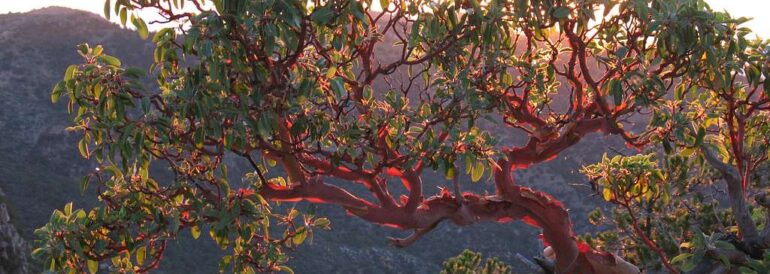Seattle, often known for its unique weather of the Pacific Northwest, presents an interesting canvas of seasonal changes of the deciduous trees. When the fall arrives, the city gets painted in beautiful hues of red, yellow and orange.
These deciduous trees are not only beautiful but form a part of the urban ecology where they offer dynamic beauty as well as practical utility all year round.
This guide will discuss the countless benefits of deciduous trees, the climate conditions to grow them (particularly Seattle’s) and the tips to choose, plant, and maintain these seasonal beauties.
What Are Deciduous Trees in Seattle?
The deciduous trees refer to a species of trees that annually lose their leaves around the fall season before they face a time of dormancy in the winter season. This cycle is an important adaptation that enables these trees to save energy and resist lower temperature and light thus ready to have a better, vigorous growth in spring.
In the climate of Seattle, knowing the difference between the deciduous and the evergreen trees is very important. Evergreens give the property shading and privacy, but deciduous trees offer a dynamic, ever changing aesthetic.
What Makes a Tree Deciduous? Understanding Seasonal Cycles
A fascinating process that lies in the making of the tree into a deciduous one is an elaborate biological response to the seasonal variation. Shedding of the leaves does not occur in response to a change in temperature, but it takes place at a fixed time of year when the hours of daylight are decreasing, usually in autumn. These are minor changes in the light that trees are able to see and this is a sign that they need to start preparing to face the cold, dark winter.
The tree also starts to take back the precious nutrients contained in its leaves in preparation to use them later. After shedding the leaves, deciduous trees become dormant. It is the very important stage of a slowed down metabolism, when the tree is saving its energy and staying safe against a harsh winter.
The impact of dormancy is that growth is severely affected, as the energy is concentrated on stabilizing and establishing the root system under the ground. Most of the deciduous trees need warmer weather to develop out of this dormant condition during the spring.
Benefits of Deciduous Trees in Seattle Landscapes
Deciduous trees have many benefits. When the summers become warmer and drier in Seattle, the wide deciduous tree canopies provide considerable shade that can have huge savings on domestic climate control. By carefully positioning such trees on the south and west side of your property, air conditioning costs can be reduced by 30%.
In contrast, during winter, when the leaves of the tree fall, the deciduous trees allow valuable sun penetration. It is often possible to use this free heat of the sun to heat your house, saving you money in heating bills as well as adding some light on the gray, short winter days.
The deciduous trees also serve as wildlife habitat and food sources. The branches of the trees offer a home and nesting spots to different types of birds and their flowers offer much-needed nectar to honey bees. The fruits and seeds are important food to birds, squirrels and other small mammals.
In addition, there is the invaluable advantage of natural mulch which is formed as a result of fallen leaves turning into compost. Leaves are useful because they regenerate organic material and essential nutrients to the soil which enhance more fertility in the soil, soil arrangement, and the capacity of the soil to hold water.
Homeowners may see a great increase in value of their property as a result of the existence of a healthy and well taken care of deciduous trees. Research shows that trees have the power to improve a property’s resale value by 15-20 percent as well as promote quicker sales of homes because of their added appeal all year round beauty.
Finally, deciduous trees are exceptionally vital in stormwater management. Their canopies will prevent rainfall such that the amount of water that will fall on the impervious surfaces can be minimized. Their root systems improve soil permeability, allowing more water to infiltrate the ground rather than running off into storm drains. This helps limit flooding, reduces soil erosion, and contributes to cleaner waterways by filtering pollutants.
Growing Conditions for Deciduous Trees in Seattle
Successfully growing deciduous trees in Seattle requires a keen understanding of the local environment, which presents both opportunities and specific challenges. Seattle’s climate is generally mild and marine, but a defining characteristic is its dry summers, typically from May through September.
While the rest of the year brings ample rainfall, the warm, dry summers mean trees can be particularly vulnerable to drought and heat stress. This necessitates proactive watering strategies. Seattle falls within USDA Hardiness Zones 8b-9a, which means it can support a wide variety of deciduous species. This warming trend, indicated by the shift from Zone 8b to 9a/9b, underscores the increasing importance of drought resilience in tree selection.
Soil preferences and drainage requirements are paramount. Deciduous trees generally thrive in fertile, well-drained soil.
Seattle’s urban environments often present specific soil challenges, including compaction from construction and foot traffic, altered drainage patterns due to paved surfaces, erosion, and nutrient imbalances.
To counteract these issues, fostering “living soil” is essential. Living soil, rich in microorganisms, organic matter, and soil fauna like earthworms, improves water retention, nutrient cycling, and boosts a tree’s resistance to diseases.
Light requirements directly impact a tree’s growth and, notably, its fall color. While many deciduous trees can tolerate partial shade, the most vibrant and spectacular autumn hues are achieved when trees are planted in full sun. Adequate sunlight “amps up” the production of pigments like anthocyanins and carotenoids, leading to more intense reds, oranges, and yellows.
Space considerations and mature sizing are critical for long-term tree health. The principle of “right tree, right place” is fundamental. Before planting, always consider the tree’s mature height and spread to ensure it won’t interfere with buildings, overhead power lines, underground utilities, sidewalks, or other structures.
Remember that a tree’s root system can extend well beyond its canopy, so adequate underground space is just as important as above-ground clearance. The best planting times for deciduous trees in Seattle are specific to our climate. Fall, particularly from October to December, is considered the ideal window. Planting during this period allows the tree’s root system to establish itself effectively, benefiting from the abundant fall and winter rains before the stress of the next dry summer season.
Finally, watering needs during Seattle’s dry summers cannot be overstated. Newly planted trees, especially during their first five years, require consistent and deep watering. From May through September, young trees should receive 15-20 gallons of water twice a week, ensuring the water soaks deep into the soil to reach the roots.
For mature trees, deep, infrequent watering is still necessary; they may require 1-3 hours of soaking irrigation monthly, depending on their size. It is important to emphasize that typical lawn sprinklers are insufficient for trees and can promote shallow root growth, making trees more vulnerable to drought stress. Using methods like watering bags or soaker hoses ensures water penetrates deeply where it’s most needed.
Featured Seattle Deciduous Trees Examples & Tree Species
Bigleaf Maple: Seattle’s Native Giant
The Bigleaf Maple (Acer macrophyllum) is an iconic native of the Pacific Northwest, a true giant among Seattle’s deciduous trees. Its name is well-deserved, as it boasts impressively large leaves, often reaching up to 12 inches across, with exceptional specimens recorded at 24 inches.
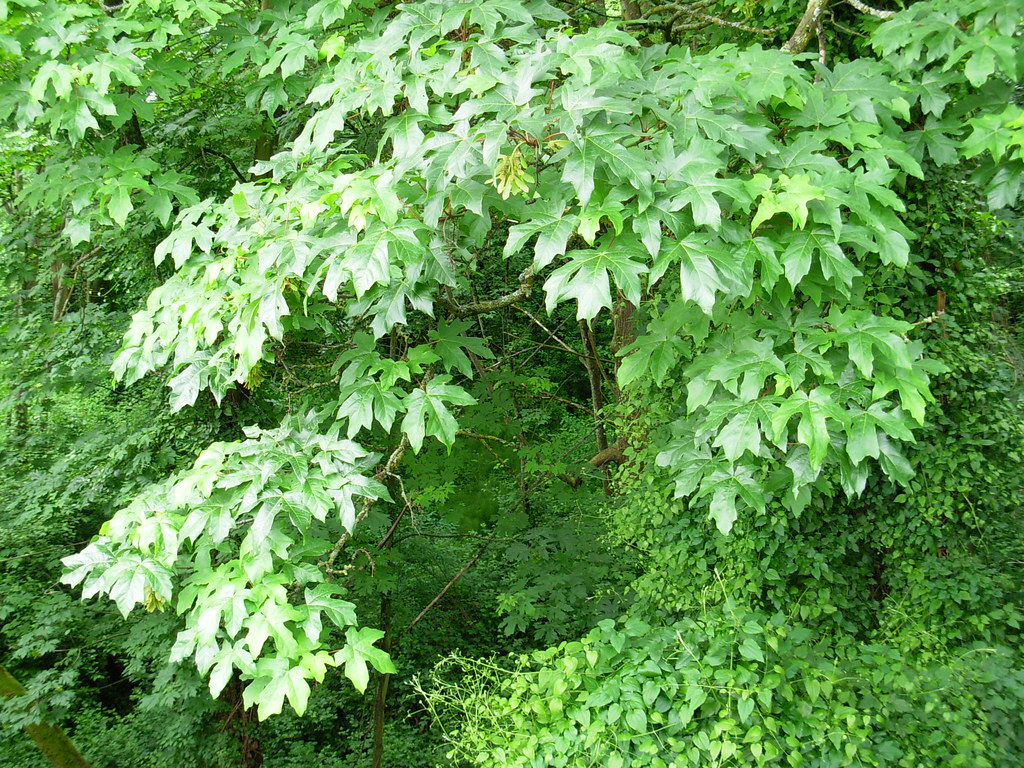
These distinctive, deeply lobed leaves create a dense canopy that provides excellent shade during Seattle’s warm summers. In autumn, the Bigleaf Maple transforms into a spectacular display of golden fall color, illuminating the landscape.
Beyond its visual grandeur, this tree is ecologically vital. Its expansive canopy offers significant habitat for nesting birds and provides an important substrate for epiphytes like licorice ferns and mosses. Honey bees are drawn to its flowers for nectar, and some birds feed on its winged seeds in winter.
While it can reach heights of 50-100 feet in urban settings, its impressive size means it requires ample space to mature. For properties with the room, the Bigleaf Maple is a majestic addition, offering both ecological value and stunning seasonal beauty.
Pacific Madrone: The Evergreen Exception
Pacific Madrone (Arbutus menziesii) is a unique tree and native to the Pacific Northwest. It is technically an evergreen, not losing its leaves at any time of the year, but its placement tells of the variation of beauty of the arboreal frame of our region.
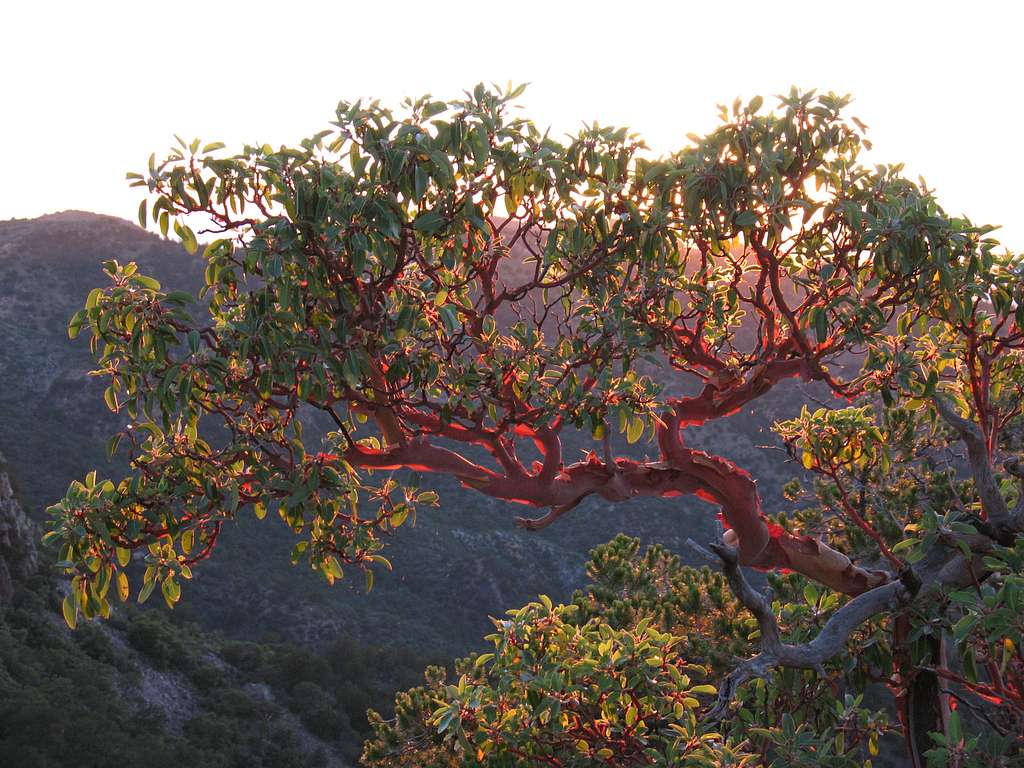
The Madrone has a spectacular, smooth, reddish-orange bark that sloughs off in thin strips to expose a new olive-green to reddish-brown layer underneath. This exciting sort of exfoliating bark also gives alluring seasonal interest.
On the tree, grow large bunches of creamy white, fragrant, flowering blossoms in the spring, and bumps of orange-red fruit that last until winter and draw a variety of bird species.
Pacific Madrones are drought-tolerant and comparatively low-maintenance. They are quite difficult to plant because they have sensitive roots, but the small and new plants have the highest survival levels.
Red Alder: The Pioneer Species
The Red Alder (Alnus rubra) is a very fast growing native deciduous tree, often found as colonizing a disturbed site like logging sites or a burnt area. This makes it an important species when conducting forest succession and restoration work in the Pacific Northwest.
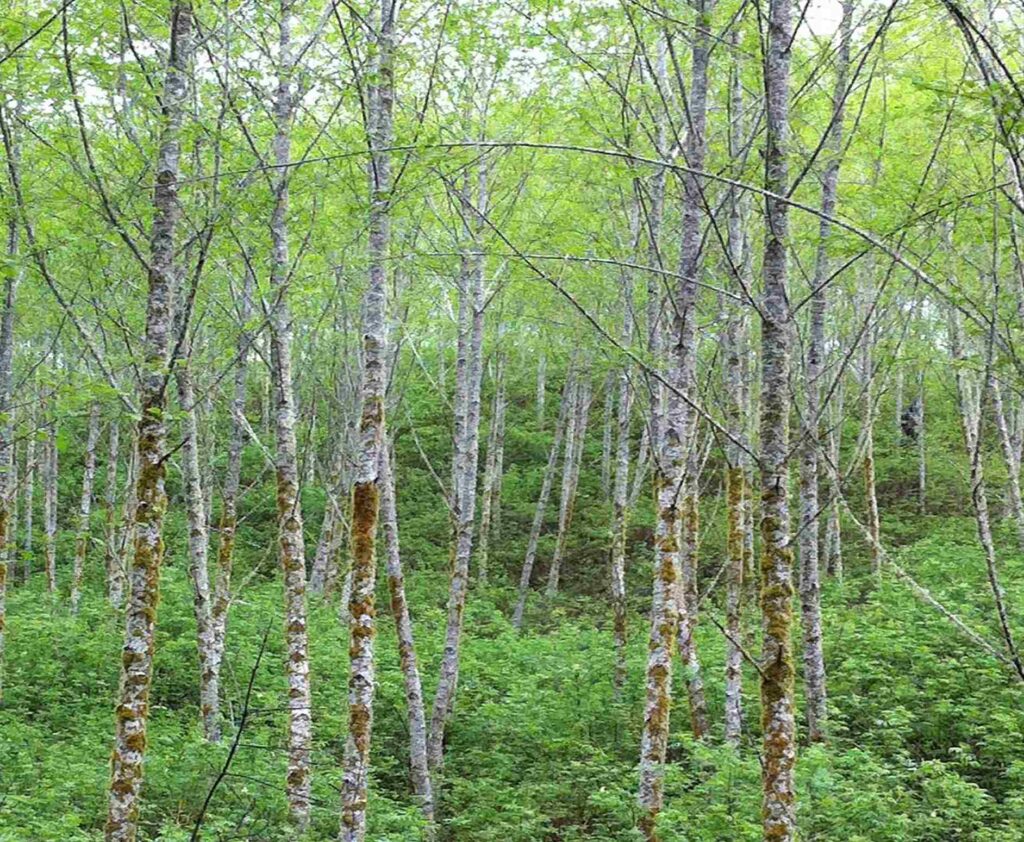
It has the capacity of enhancing soil through nitrogen fixation. Its roots also contain nitrogen-fixing bacteria located in nodules which convert atmospheric nitrogen into a usable form thereby enriching the soil. The Red Alder can grow in soils low in nitrogen, which is why we can use it as a central element of the degraded landscapes.
Oregon White Oak: Seattle’s Heritage Tree
Oregon White Oak (Quercus garryana) is a true heritage tree in Seattle and the overall Pacific Northwest. These are towering deciduous trees with huge branching trunks and wide tops. Oregon White Oaks may have poor growth but their longevity is unrivaled with mature trees having the capability to last 500 years or more and can become lasting structures in the landscape.
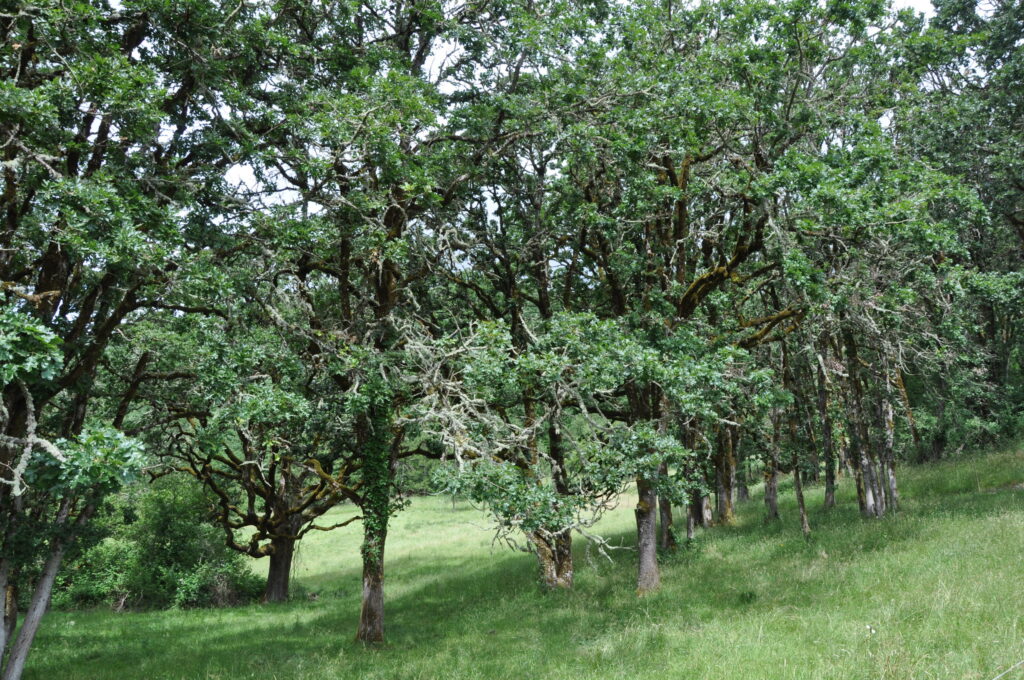
Ecologically, the Oregon White Oak is a cornerstone species, providing invaluable wildlife habitat. Its abundant acorns are a critical food source for a wide array of animals, including deer, elk, bear, squirrels, chipmunks, turkeys, and numerous bird species. These oaks are remarkably drought-tolerant, well-suited for exposed, dry sites, and historically maintained by periodic fires that prevented more competitive species like Douglas-fir from overtaking them.
Their distinctive features, including deeply lobed leaves and thick bark, make them easily identifiable. Planting Oregon White Oaks is a long-term investment in your property and the region’s natural heritage.
Vine Maple: The Understory Beauty
Vine Maple (Acer circinatum) is one of the most popular and diversely utilized native deciduous trees in Seattle, famous for its adaptability and dazzling seasonal appearance.
Commonly growing as an understory tree in the coniferous forests, the species is adequately sized to fit in small urban lots and gardens, usually measuring well grown at 20-25 feet tall and wide. It is graceful, multi-stemmed, and produces a tiered effect in the landscape with the reddish-green bark and twisted branches exposed.
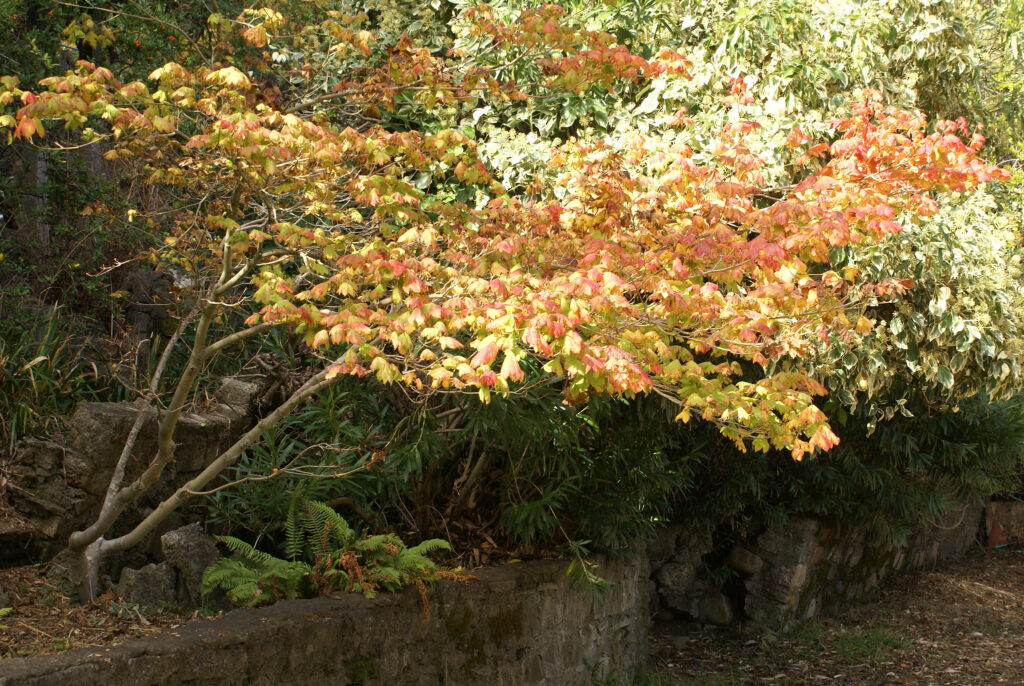
The most interesting thing about the Vine Maple is its spectacular autumn color. The leaves are fragile, circular, and their color palette in autumn is truly mind-blowing by the number of colors it encompasses, ranging in reds, oranges, and yellows.
In addition to being beautiful, the Vine Maple is an exceptionally adaptable tree which makes it a good candidate to grow in woodland gardens or even those hard shaded areas in your yard. Its small fruits are edible, birds enjoy them and the flowers attract hummingbirds and butterflies.
Small Deciduous Trees for Seattle: Perfect for Urban Properties
Seattle’s urban landscape often features smaller lot sizes, courtyards, and areas with overhead power lines, which necessitate careful tree selection. Fortunately, many compact deciduous trees thrive here, offering seasonal beauty without overwhelming limited spaces.
When considering a small deciduous tree, look for varieties that mature at under 25 feet in height and spread.
These compact options are ideal for planting near homes, along narrow planting strips (typically 5+ feet wide), or beneath utility lines where taller trees would pose a conflict.
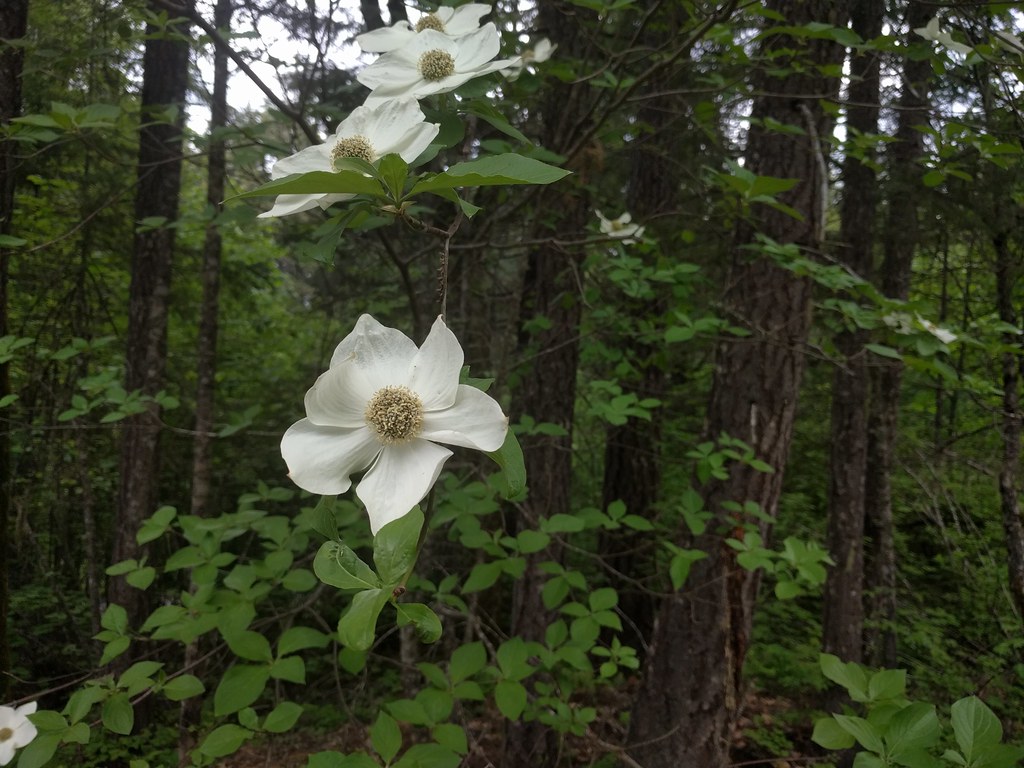

- Pacific Dogwood (Cornus nuttallii): A beautiful native that grows to about 35 feet tall with a 20-foot spread. It features large white spring blooms and reddish-purple fall foliage, attracting birds. Its moderate size makes it suitable for shading driveways or smaller sections of a yard.
- Vine Maple (Acer circinatum) is an exceptional native choice, typically reaching just 20-25 feet tall and wide. Its delicate leaves provide stunning fall colors, ranging from brilliant reds to oranges and yellows, and its naturally spreading, multi-stemmed form offers beautiful year-round structure.
Seasonal Care for Seattle’s Deciduous Trees
Summer (June-August): Watering Strategies and Growth Management
- Deep Watering: During periods without significant rainfall, newly planted trees need 15-20 gallons of water twice a week. Mature trees require substantial deep soaking, potentially 1-3 hours of irrigation monthly, depending on size. Focus on slow, deep watering to encourage robust, deep root systems, rather than shallow, frequent watering from lawn sprinklers, which is insufficient.
- Light Pruning: Summer is a good time to remove water sprouts and suckers as this helps suppress their growth. Avoid heavy pruning during summer, as trees are already under stress from heat and drought.
Winter (December-February): Dormancy Care and Protection
- Pruning: Winter, when deciduous trees have lost their leaves, offers the clearest view of a tree’s structure, making it the ideal time for most structural pruning. Pruning during dormancy encourages a burst of new growth in spring and reduces the spread of pests and diseases. Be sure to wait until after the winter solstice to avoid issues with fall pruning, which can be problematic due to increased decay fungi spores and slow wound closure.
- Root Protection: Apply a thick layer of mulch around the tree’s base to provide insulation for the roots, protecting them from cold snaps.
- Supplemental Watering: Even in winter, dormant trees may need supplemental moisture if conditions are unusually dry and they are not receiving adequate water from the environment.
Common Challenges When Growing Deciduous Trees in Seattle
Leaf Management and Cleanup
The leaf drop is good for the soil but leaves a big cleanup activity especially for large trees. Leaves, when accumulated can kill grass, cause walkways and driveways to be slippery and block the drains. Make use of equipment such as leaf blowers and tarps to collect. Think about mowing over leaves in your garden or leaving a thin cover of leaves to compost down into the soil and reduce the amount of waste that is created, getting a free fertilizer.
Potential Pest and Disease Issues
Seattle trees may encounter problems of invasive species such as spongy moth, aphids, scale insects, and multiple fungal diseases due to Seattle’s moisture.
Make sure watering and the soil conditions are in order by using mulch and aeration. Regularly inspect your trees for signs of distress and contact a certified arborist for professional assessment and treatment if you suspect a serious infestation or disease.
Summer Drought Stress
Seattle’s increasingly dry summers can lead to drought and heat stress, manifesting as wilting, scorched foliage, premature leaf drop, or stunted growth. This stress makes trees more vulnerable to other problems. Implement deep and infrequent watering practices, especially for young trees (15-20 gallons twice a week from May-September) and mature trees (1-3 hours soaking monthly).
Use soaker hoses or watering bags to ensure water reaches deep roots. Apply organic mulch to retain soil moisture and moderate temperature extremes. Avoid heavy pruning during drought periods.
Root Competition in Urban Environments
In developed areas, limited space, compacted soils, and proximity to structures can force tree roots to grow upward or become girdled, leading to exposed roots, stunted growth, and damage to infrastructure. Soil compaction is a leading cause of urban tree mortality.
When planting, choose tree species appropriate for the available space, considering their mature root systems. Avoid planting trees too close to foundations or pipes.
For existing exposed roots, apply a thick layer of organic mulch or plant non-grass ground cover to protect them. Never add more soil over exposed roots, as this can suffocate them. Aerate compacted soil around trees to improve water and oxygen penetration.
Branch Structure and Storm Damage Prevention
Seattle experiences strong winds and occasional heavy snowfalls, which can lead to branch breakage or even whole tree failure, posing risks to property and public safety.
Weakly attached limbs or poor branch structure increase this risk. Regular, professional pruning is the best preventative measure.
Selective thinning of dead or weakly attached limbs strengthens the tree’s structure and reduces the likelihood of failure.
Professional Tree Services for Deciduous Trees in Seattle
Although a homeowner can cope with most of the tasks involved in taking care of a deciduous tree, it is important to note that there are certain circumstances under which an expert consultation is necessary. By understanding when to request the services of a certified arborist, you may save your investment, make your environment safer and see your trees in good health far into the future.
When to Call Professionals for Deciduous Tree Care
- Large-scale pruning or structural pruning
- Tree health and safety assessments
- Installation of support systems
- Tree removal considerations
- Complex planting projects
- Soil improvement and specialized fertilization
Frequently Asked Questions About Deciduous Trees in Seattle
When is the best time to plant deciduous trees in Seattle?
The best time to plant new deciduous trees in Seattle is in the fall, specifically from October to December.
How do I manage fall leaf cleanup effectively?
To manage fall leaf cleanup efficiently, wait until 50-70% of the leaves have fallen. Use a leaf blower to gather leaves into piles, then rake them onto a large tarp for easy transport. You can dispose of leaves in yard waste bags or add them to a compost bin to create nutrient-rich soil amendment. Alternatively, consider mulching leaves with your mower and leaving them on your lawn or in garden beds to act as a natural fertilizer and soil protector.
Why do deciduous trees lose their leaves in the fall?
Deciduous trees lose their leaves in the fall primarily as an adaptation to conserve energy and moisture, and to protect themselves from cold winter temperatures. The process is triggered by the shortening daylight hours, not directly by temperature.
Which deciduous trees have the best fall color in Seattle?
Seattle is home to many deciduous trees that offer spectacular fall colors. Some of the best include Vine Maple (Acer circinatum) with its vibrant reds, oranges, and yellows; Golden Ginkgo Biloba (Ginkgo biloba) known for its brilliant gold; Sweetgum (Liquidambar styraciflua) displaying fiery reds to deep purples; and Red Oak (Quercus rubra) with its radiant red, orange, and purple hues. Other notable trees include Pacific Dogwood, Black Tupelo, Katsura tree, Japanese Maples, and Autumn Blaze Maples.
Do deciduous trees need different care than evergreens?
Yes, deciduous trees generally require different care than evergreens, primarily due to their seasonal leaf drop and dormancy cycle. Deciduous trees need specific pruning times, and their watering needs are particularly critical during Seattle’s dry summers when they are actively growing.
How long do deciduous trees live in Seattle’s climate?
The lifespan of deciduous trees in Seattle’s climate varies significantly by species. Generally, many deciduous trees live for a century or less. For example, some common species like Bigleaf Maples and Red Alders often reach the end of their lifespan around 60-100 years. Certain ornamental varieties, like Kwanzan Cherry, have even shorter lifespans, typically 15-25 years. In contrast, native conifers can live for over 1,000 years.
What time of the year do deciduous trees lose their leaves in the northern hemisphere?
In the Northern Hemisphere, deciduous trees typically begin to lose their leaves in the fall, usually starting in September and continuing through November.
Conclusion: Creating Your Seattle Seasonal Landscape
Deciduous trees are truly the seasonal beauties of Seattle, offering a dynamic and ever-changing landscape that enriches properties throughout the year. From providing essential summer shade that reduces energy costs and allowing warming winter sun to penetrate your home, to their spectacular fall color displays and vital contributions to local wildlife habitats and stormwater management, their benefits are profound and multifaceted. These trees are not just a visual delight; they are a smart, living investment in your property’s value and the ecological health of our urban environment.
By understanding Seattle’s unique climate and soil conditions, selecting the right species for your space, and committing to proper seasonal care, you can cultivate a thriving deciduous tree landscape. We encourage you to delve deeper into the specific needs and characteristics of individual species by exploring our detailed articles on Seattle’s Native & Common Trees.
For complex tree care needs, or if you’re unsure about the best approach for your specific trees, remember that professional arborist consultation is always available to ensure the long-term health and safety of your arboreal assets. Embrace the seasonal magic that deciduous trees bring, and create a vibrant, resilient landscape that truly reflects the beauty of the Pacific Northwest.
